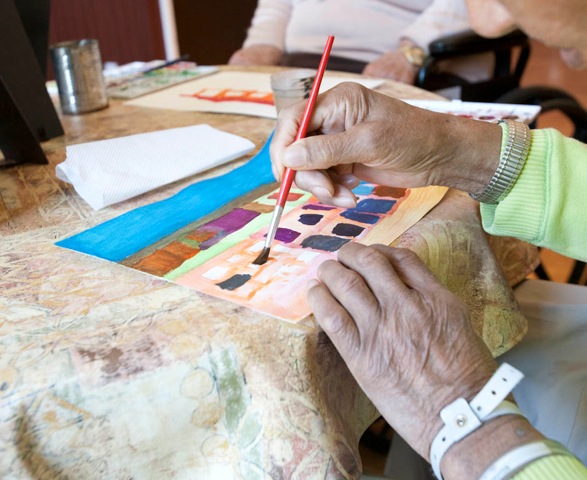
When expressionist painters like Pablo Picasso, Otto Dix and Barnett Newman waved their defiant brushes over blank canvases, they rebelled against the “logical minds” that had brought about one World War, then another. Art, they insisted, should free the mind from oppressive reality.
So it’s not surprising that in the shadow of the Beat Generation and Sixties counterculture, a Bay Area arts program has gained prominence in helping older adults circumvent constrictive thought to free the artist within.
Since its modest inception in 1991, San Francisco-based Art With Elders has helped 6,000 seniors overcome doubt, forge artistic camaraderie, improve health and enhance creativity.
Executive director Mark Campbell first stumbled onto an Art With Elders exhibition at San Francisco’s Flax Art & Design when purchasing art supplies. Impressed by the boundless creativity of elder artists – and disillusioned by the “restrictive academia” of his Academy of Art alma mater – Campbell signed on as an instructor.
For him, the magic of painting meant circumventing the mind to tap into the mystery of artistic expression.
Campbell recalls a group of dementia patients who were so cognitively impaired they were under “wander guard” to ensure their safety. Yet Campbell was astonished to see the quality of their painting – a thrilling rejection of the objective world.
“We found that as we juried for the arts show, much of their work was selected… because (it) was so unique,” he says. “And quite incredible.”
Some of Campbell’s students have worked with him for the past 20 years and have gained powerful artistic life lessons: inspiration, friendship, health and confidence.
“There’s obviously a transcendental benefit to creativity,” he says.
An avid patron of Bay Area arts, Clint Hill reverently attended ballet and theater events before his retirement as a psychologist and drug counselor. Now living at Excell Health Care Center in Oakland, Hills compliments the Art With Elders program for being a supportive and non-threatening environment.
“I never looked at myself as a drawing artist,” says Hill. “But I do now.”
Art With Elders is now offered in 30 sites, ranging from skilled nursing facilities to retirement communities and senior health centers.
In 2010, Chinese artist and former Shanghai school administrator Tony Yu suffered a stroke and lost the use of his right hand – which he used to paint. Not only did he have to learn how to draw again, but left-handed. Yu, 90, first learned to draw still life objects, then slowly gained in expertise, taking on more complex subjects, progressing to portraits and eventually landscapes.
“Your creativity… gives you an opportunity to refine your problem-solving skills,” says Zarouhie Abdalian, an instructor for the past three years. “Almost invariably something unusual and successful comes out of it.”
Abdalian – known affectionately to her students as “Z” – says older adults frequently enter the program frightened and insecure.
“Most of them come in and say they can’t make art,” she says. “There’s a lot of fear around the blank page.”
Abdalian says students invariably adopt a more open, relaxed and fearless approach.
“One student described to me what death looks like and diagramed how she would make the space of death as an installation,” says Abdalian. “Another student has drawn erotic images of past lovers, and another obsessively draws the house in which lives the family she longs for. It’s a risk to make visible what is intimate and to share this with others.”
Founder Brent Nettle initially formed the non-profit organization Eldergivers in 1986 to reduce social isolation among nursing home patients. Five years later, his organization launched Art With Elders.
A decade after that, the program gained popularity with several high-profile exhibitions including San Francisco’s de Young Museum, the Yerba Buena Center for the Arts, the city’s Main Library and the Di Rosa Preserve in Napa.
A pioneer in the field of arts and aging, Nettle – a Christian Scientist – for two years refused medical treatment for an illness that remained undiagnosed. He passed away on June 1st and was honored at a memorial service later that month.
Today, the fiscally-challenged Eldergivers has focused its efforts solely on the Art With Elders program, which serves 450 students annually. When fully staffed, it employs 19 part-time instructors, operating on a 2013 budget just over $250,000.
A staple at Laguna Honda Hospital and Rehabilitation Center, Art With Elders once offered culturally specific classes taught by Spanish and Cantonese-speaking instructors. Although both have lost funding, private financing was recently secured to continue a class with an African-American focus.
Art With Elders recently contracted with adult service provider On Lok Lifeways to offer instruction at a handful of facilities that offer PACE – the Program of All-Inclusive Care for the Elderly.
Campbell says researchers are frustrated by the poor performance of prescription drugs in slowing progression of dementia – Alzheimer’s in its most common form. Today, he’s in negotiations with officials at the notable UC San Francisco Medical Center who want Art With Elders to help them study the cognitive skills of artists over time compared to a control group.
The study could prove scientifically what arts administrators have known for years: “Creativity has a dramatically positive benefit on cognitive decline,” says Campbell.
“I definitely see improvements in their mental and emotional health,” says Abdalian, who is currently studying to become a patient advocate. “Classes develop community and camaraderie among one another which is really important for their health.”





